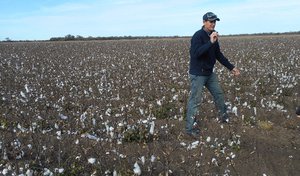Advertisement
Published: June 29th 2014

 On the Huge Cottonfield
On the Huge Cottonfield
Scott was able to show us what happens during harvesting, even though it was finished here. There was still a lot of lint and cotton bols on the plants, which would be allowed to rot into the ground to provide nutrients. We were standing in one enormous field, to the horizon on this picture.We were picked up from outside the Showgrounds for our Cotton Tour, although the bus was rather late and I started worrying that he’d forgotten us. There were already 9 other people on the small bus and as we were the last, our guide, Scott, started to give us a run down on what the tour would entail. Unfortunately, all the cotton had been picked in the local area so we wouldn’t be able to see the harvesting, but he had organised for us to see the machine up close on one of the farms. We drove right into one of the huge fields and got out to see the denuded plants (well almost – they miss a lot of the lint!) and watch the machine that pulls the rest of the plant out of the ground. They leave them to rot and provide nutrients to the soil, which is highly organic black soil and great for growing crops. They can also plant other crops directly onto the fields without ploughing and we saw a few green shoots appearing in some fields amongst the cotton remains.
The cotton harvesting machine, which we got up close and personal to,

 Cotton Fields Irrigation
Cotton Fields Irrigation
This large irrigation channel (which would be full of water during the growing season) was at the head of the field and the black pipes fed the water to each row of cotton plants. They had to be started flowing manually and the farmer had to beware of snakes that had settled in them when not in use!is huge. They use an American machine that can pick 6 rows at a time using little jagged rotating fingers which then pass the bols through to a blower that deposits them in the bin. There they are compressed into a large roll, wrapped in yellow plastic and the roll is dropped onto the ground to be picked up and transported to the ends of the field and ultimately to the Gin. All this in one machine operated by one person! Efficient but not very good for all the people who used to get work at harvest time under the old labour intensive methods!
We then made our way to the Cotton Gin, past the ends of the fields, where Scott showed us how they are irrigated using water channels and black pipes that feed the water to each row. He said the pipes have to be started flowing by hand and it wasn’t unusual to pick one up and find a snake crawling out of the end! The fields are sloped so that any runoff water is collected and kept in a storage dam for future use. Very environmentally minded.
At the Gin,

 The Cotton Harvester
The Cotton Harvester
This huge machine could take the cotton bols off five or six rows of plants at once. Then turn them into a large round bale wrapped in yellow plastic. All controlled from an air-conditioned cabin. we were taken into the control room where we could see the Saw Gin working. It looked like snow passing down the front of the machine in one continuous sheet. Before that the bols are cleaned of the rubbish, sticks and leaves etc. Then they pass through the 170 circular saws that are in each machine, which pull the lint apart and have an attachment that traps the cotton seeds and sends them to a hopper. These are valuable, too, and are sold to be used in cooking oil, fuel etc. The lint is then cleaned and sent to a hopper where it is compressed very tightly into 227kg bales which are strapped by heavy wire that, then twisted and cut all within seconds. The bale is then sent for test samples to be taken from top and bottom of it, then labelling and it finally passes out to the loading dock where a forklift with enormous arms comes and grabs 6 at a time and races off to stack them for transport. I was amazed at the weight the forklift was picking up in one go.
We could see quite a few of the processes occurring

 Round Bales
Round Bales
Round bales are loosely compressed, wrapped in plastic and dropped to the ground. they are then picked up and stacked in very long rows around the edge of the field waiting to go to the gin. It still feels fluffy at this stage.on the monitors in the control room, including the first step, cutting and removing the yellow plastic cover from the round bales, which was done by hand by a lady; the forklift rushing about collecting the bales; even the lint being processed from deep inside the machine. Scott gave us each a sample bag which had some cotton bols, some seeds and some clean cotton lint, which is very soft – even more than cotton wool as it still has some of its oils in it. The tour was $35, which we had thought rather expensive, but we’d had our money’s worth so I’m very glad we did it.
We were dropped off back at the Showgrounds and had lunch in the van, then went to look in the town. Millers was having a sale so I managed to get another warm-shirt and a thick cardigan cheaply. We then had a look in the Art Gallery where I was very surprised to find a gallery upstairs showing a lot of lithographs by Charles Condor (one of the Heidelberg School artists), some quite risqué. I had no idea he did lithographs, having only seen his oil paintings in

 Saw Gins
Saw Gins
The cotton bols pass over the 170 saws in the machine which rips them apart, traps the seed and sends it to a hopper. You can see the separated lint falling down like snow at the front of the Gin.Sydney and Melbourne Galleries.
I finished the day by spending a couple of hours at the local library uploading all the Lightning Ridge blogs (we’re running out of data on our phone plan so I needed to use their WiFi) while Barry did some shopping. All went well and I was the only patron for most of the time!
Finally, home for dinner and getting ready to move on tomorrow.
Advertisement
Tot: 0.144s; Tpl: 0.012s; cc: 10; qc: 58; dbt: 0.09s; 1; m:domysql w:travelblog (10.17.0.13); sld: 1;
; mem: 1.1mb









Pitt
non-member comment
saw ginning machine
The sawtooth hooks the fiber rotates, passes through the adjacent crimping rib clearance, the cotton fiber is brushed, enters the cotton collection box; the cotton is blocked by the rib, passes through the cotton comb to discharge the machine. This is the cotton ginning process. For more information, please click on https://www.testextextile.com/product/lab-saw-cotton-gin-tb510b/